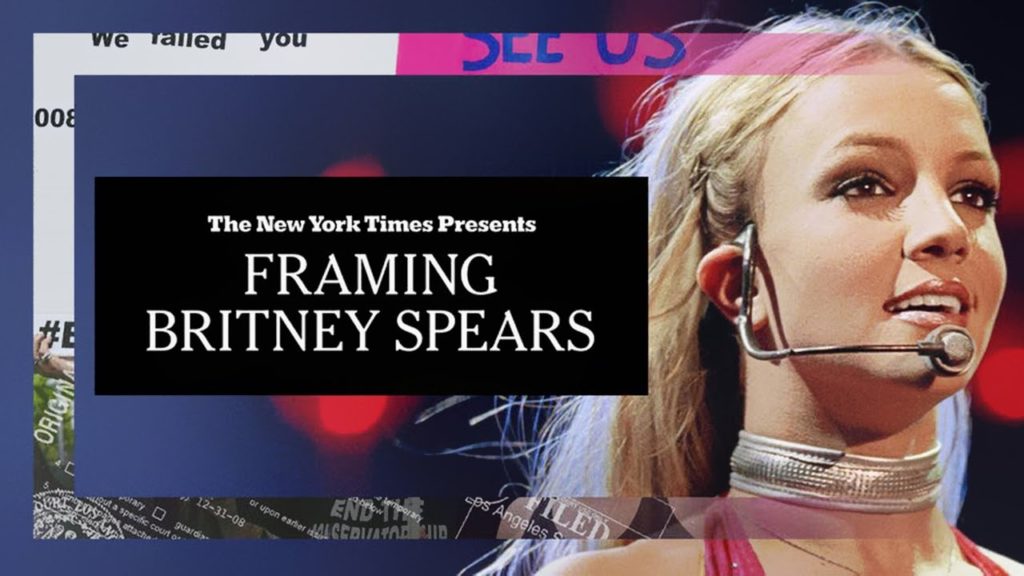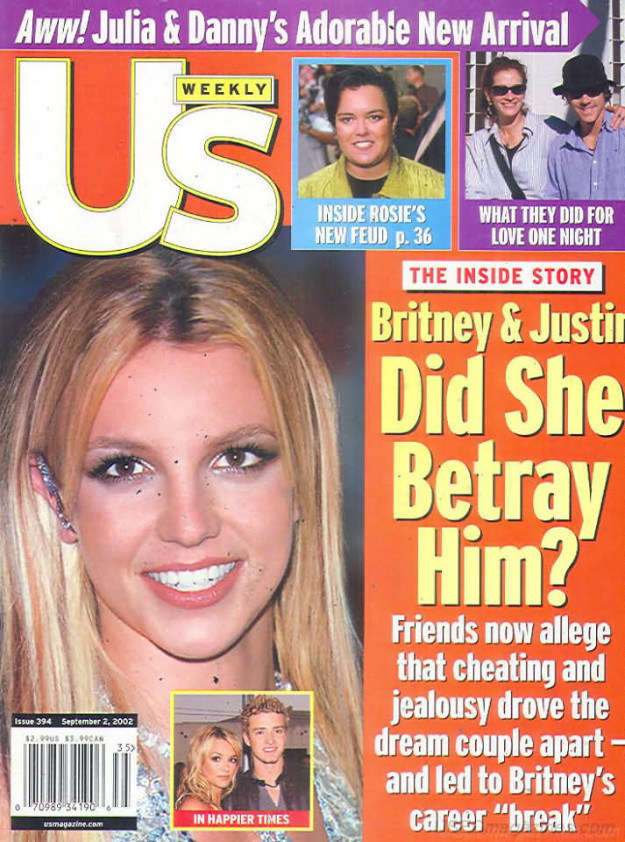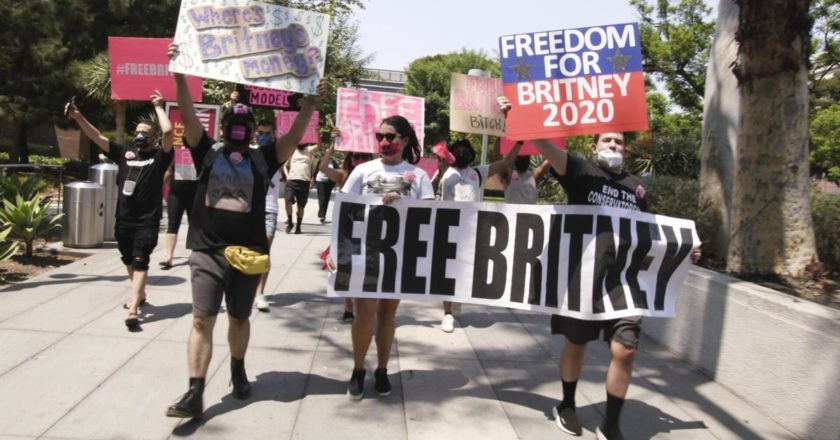Why has the Free Britney movement suddenly gained mainstream recognition?
“Framing Britney Spears” is the latest installment of The New York Times’s new docuseries, The New York Times Presents, and released exclusively on Hulu. In each episode, The New York Times journalist team takes viewers on a deep dive into a modern news story, which includes topics ranging from bushfires, bitcoin scandals, to most recently—Britney Spears.
While the #FreeBritney movement has existed for many years, only recently has the campaign gained greater public recognition, in no small part due to the increased media coverage of Britney’s conservatorship and personal struggles. 23 years after Britney Spears’ musical debut in the hit album ...Baby One More Time, she has once again taken the world by storm, but this time, through the fight for her freedom.

Who is Britney Spears?
Britney Jean Spears was born on Dec. 2, 1981, in McComb, Mississippi. Spears spent the bulk of her childhood in Kentwood, Louisiana, a small town in the Bible Belt, with her working-class parents and two siblings. From a young age, Britney’s parents recognized her talent for performing and encouraged her participation in a variety of talent competitions, TV commercials, and auditions. Britney spent most of her summers in New York City with her mother, Lynne Spears, while her largely absent father, James “Jamie” Spears, grew increasingly concerned about recuperating the financial costs of her career. Often in between jobs, Jamie Spears struggled with alcoholism and eventually filed for bankruptcy in 1998.
Britney’s big break came in 1993 when she was cast in The All New Mickey Mouse Club at the age of 11. From there, Britney’s career took off, and she signed a development deal with Jive Records at just 15 years old, releasing what would become her hit single, “…Baby One More Time” two years later. In a time where boy bands were the dominant force in pop music, Britney’s overnight success was especially notable. The provocative and sexual nature of her music videos and song lyrics led to both praise and criticism and became a defining feature of Britney’s public image. Many teenage girls found themselves relating to the themes conveyed through Britney’s music, which described adolescence, unrequited love, and personal experimentation. With the subsequent release of albums Oops! … I Did it Again (2000) and Britney (2001), Britney Spears quickly became a household name.
Britney’s Relationship with the Media and Paparazzi

As Spears rose in popularity, so did her relationship with the paparazzi and the media. Britney’s high-profile relationship with Justin Timberlake caught the attention of many media outlets who dubbed them the “perfect couple.” During this relationship, interviewers often asked Britney for invasive details about her intimate life. When the couple broke up, Justin Timberlake claimed that Britney cheated on him, painting her as a “slut”.
In 2004, Britney became engaged to Kevin Federline, attracting the attention of the media once again. Despite Britney’s initially friendly interactions with the paparazzi, the relationship soon became strained after Britney’s back-to-back pregnancies.
Despite Britney’s desire for privacy, the media became increasingly curious about her personal life, specifically pushing the narrative that she was an unfit mother. Photographing Britney, specifically with her children, became a lucrative business for the paparazzi, with a single photograph worth up to a million dollars.
Britney’s Public Mental Decline
Spears and Federline divorced in 2006, prompting a messy legal battle over custody of their two children. It was at this time, after the media’s constant involvement in her personal affairs, that Britney began to lose interest in her carefully crafted image. She shaved her head in 2007, explaining “I’m tired of everyone touching me.” After Britney attempted, unsuccessfully, to see her children at Kevin Federline’s estate, she famously attacked the side of a paparazzo’s car with an umbrella after he followed her to Jiffy Lube. Britney’s public outbursts and stints in rehab contributed to the “Britney gone wild” reputation that the media constructed. Paparazzi frequently swarmed Britney at her court dates and surrounded her at public establishments such as restaurants. Amidst this mental health crisis, Britney lost custody of her children in October 2007 and was only given visitation rights. During the time, the public largely glamorized Britney’s struggles rather than focusing on the help she needed.
At the end of 2007, Britney fired her previous manager and became romantically involved with Sam Lutfi, who was publicly believed to be “using” Britney for fame. Lutfi was known for attaching himself to celebrities while they were emotionally vulnerable. Jamie and Lynne Spears viewed him as the main contributor to Britney’s mental decline. In January 2008, Britney was taken by an ambulance after barricading herself inside her own home and refusing to hand over her children to Federline. Following this custody dispute, the court indefinitely suspended Britney’s right to see her children.
In February 2008, Britney Spears was hospitalized twice under 5150 holds. In a 5150, an individual is involuntarily placed in a psychiatric unit for up to 72 hours if they are believed to be a danger to themselves or those around them due to mental illness. One day after Britney’s hospitalization, Britney’s father Jamie Spears was granted temporary court-approved conservatorship of Britney, a position he still holds today over a decade later. Typically, conservatorships are used for elderly individuals deemed unable to make decisions and control their assets. In contrast, Britney was a young, successful, and productive celebrity, which made the request for conservatorship extremely unusual. Before this conservatorship, Jamie Spears was not a prominent figure in Britney’s life, but through this move, he suddenly gained control over her estate, assets, and person.
Life Under the Conservatorship
In his position as conservator, Jamie Spears receives approximately $130,000 a year and 1.5 percent of gross revenues from Britney’s four-year Las Vegas residency. As a conservatee, Britney’s freedom, both public and private, is extremely limited. Spears cannot legally make personal or financial decisions without the prior approval of her father and other co-conservators. Although the specific details of her conservatorship remain private, in 2016, the New York Times reported that Britney’s conservators dictated everything from her personal visitors, daily purchases, and contact with the outside world by maintaining 24-hour surveillance over her actions and medical records. Most significantly, Jamie Spears allegedly controls Britney’s custody arrangement with her children, which fans speculate led to Britney’s seeming compliance for many years.
Despite being deemed mentally unfit to care for herself, starting from 2008, Britney’s career began to make a “comeback,” with her conservators arranging various recording, touring, and TV contracts. During this time, Britney released several albums, including Circus (2008), Femme Fatal (2011), Britney Jean (2013), and Glory (2016), and appeared in Season 2 of The X Factor as a celebrity judge, signing a record-breaking deal of 15 million dollars. Additionally, from 2014 to 2018, Britney held a Las Vegas residency where she performed her “Piece of Me” show over 250 times. Under the conservatorship, Britney’s estate has grown to a valuation of almost $60 million, an immense amount of capital that she legally cannot access on her own.
Partial Collapse of the Conservatorship
Only recently has the conservatorship’s illusion of control begun to crumble in the public eye. In 2018, days after Britney revealed her new Vegas residency, titled “Domination,” she abruptly took to Twitter to announce that her show would be indefinitely postponed due to her father’s health issues. During this time, tensions mounted within the conservatorship team itself, and co-conservatorship Andrew Wallet resigned after demanding a raise to $426,000 per year. In September 2019, Jodi Montgomery, Britney Spears’ longtime care manager, became Spears’ temporary conservator after Jamie Spears was involved in an alleged physical altercation with Britney’s 13-year-old son. Despite his alleged lack of involvement in Britney’s day-to-day care, Jamie Spears remains in charge of Britney’s financial affairs. In August 2020, Britney Spears’ legal team filed court papers petitioning to permanently remove Jamie Spears as a financial conservator. Though unsuccessful in this attempt, in February 2021, days after the release of the NYT documentary, the court agreed to instate the financial company Bessemer Trust as a financial co-conservator alongside Jamie Spears in a supposed equal position.
Britney herself has attempted to escape conservatorship, or at least grant power over her assets to someone other than her father. In 2020, Britney said that she was “strongly opposed” to Jamie Spears continuing the conservatorship and having sole control over her estate. Additionally, court documents from September 2020 reveal that Britney “welcomes and appreciates the informed support of her many fans,” seemingly referring to the support on social media and other outlets.
The Influence of Social Media
Additionally, many fans interpret Britney’s cryptic Instagram posts—depicting her dancing, answering Q&A’s, and reposting miscellaneous images and quotes—as coded cries for help, with top comments requesting Britney to wear or say certain things as to covertly communicate with her fans.
In 2019, the “Britney’s Gram” podcast, which dissects Britney’s social media accounts, claimed to obtain a recording of a member of the conservatorship’s legal team. The unnamed paralegal alleged that Britney had been involuntarily committed to a mental facility and forced to cancel her Vegas Residency as a result of her attempts to break free from her conservators. He claims that Britney had refused to take her medicine and was seen driving on her own, an action prohibited under the conservatorship. This story was unable to be corroborated by other major news outlets and was denied by Britney’s manager, Larry Rudolph.
The recent NYT documentary, “The Framing of Britney Spears,” led to further public discourse and recognition of Britney’s plight. Justin Timberlake subsequently apologized for his role in her public slut-shaming.
As a result of these discoveries, the “Free Britney” movement, previously composed only of “superfans,” began to gain widespread media recognition and legitimacy. Several celebrities, including Miley Cyrus, Rose McGowen, Sarah Jessica Parker, and Paris Hilton, have lent their support, and the hashtag #FreeBritney often trends on Twitter.
Why Should We Free Britney?
Britney has been exploited for fame from a very young age, whether by her parents or the media. Her talent has been overshadowed by the demands of the paparazzi who constantly meddle in her personal affairs, contributing to her mental decline.
In more recent years, Britney has been painted as a pop icon, as her songs from nearly two decades ago are still popular today. Now, the Free Britney movement has exposed many of Britney’s fans to the dark side of her rise to fame, from the sexualization of her work and personal identity to her misrepresentation in the media to concerns about her current conservatorship.
Throughout the past thirteen years, Britney’s conservators have tightly controlled her public and media appearances, a circumstance corroborated by several interviewers and networks. Still, using what limited information they can find, Britney’s fans have pieced together a narrative they believe paints a chilling picture of her life in captivity. Clips from the 2008 documentary “Britney For the Record,” show Britney’s apparent unhappiness at her lack of freedom, marking her first and only public statement on conservatorship.
From the surface, the case seems cut and dry: We should “Free Britney” from the grips of her money-hungry father so that one day, she may find real freedom. As all stories go, however, we must consider multiple sides to paint a more complete picture.
Potential Counterarguments to the Free Britney movement
Online, most fans believe the conservatorship should be ended because Britney’s Vegas residency and public appearances seem to prove that she has the mental capacity to care for herself. However, Josephine Gittler, a law professor and author of “Reforming the Guardianship and Conservatorship System: An Introduction” explains in a Vox article that simply because a conservatee has the ability to remain productive in one part of the life does not mean they should be considered legally competent enough in all aspects of their livelihood.
In a 2019 article by USA TODAY, L.A. lawyer Troy Martin says, “Everybody looks at conservatorship as a terrible thing foisted on her. I look at it as a success story… Britney was in a downward spiral, there were 5150s filed on her as a possible danger to herself or others. Her life was a wreck. … By all appearances, things are a heck of a lot better now than they were in 2008.” In May 2019, Britney’s former manager Larry Rudolph echoed the sentiment that the conservatorship was largely helpful for Britney. In the same article, USA TODAY author Devon Link writes, “[Britney] has not publicly shared a desire to end the conservatorship and has continued to profit financially and expand her career. We found no evidence Spears is unwillingly being kept in an abusive conservatorship.”
Additionally, despite what the general public may think about Spears’ lack of control over her social media, Spears has publicly stated on video that she controls her Instagram herself. In 2019, seemingly in response to the fan speculation, Spears said, “For those of you who don’t think I post my own videos, I did this video yesterday”. Likewise, Spears wrote in a cryptic new Instagram post, “I didn’t watch the documentary but from what I did see of it I was embarrassed by the light they put me in … I cried for two weeks and well …. I still cry sometimes.” In the caption of the video post, which depicts her dancing, Spears seems to groups the documentary in with the rest of the media, who she claims has been “judged… insulted… and embarrassed” by. While many fans believe Britney is forced to bend to the conservatorship’s will, her own words may indicate otherwise.
Should we believe Britney at face value? Is there something more sinister going on behind the scenes? These questions can hardly be answered with a clear-cut answer. Still, it is clear that aspects of the conservatorship hardly have Britney’s best interests in mind.
Our Opinions on the “Framing Britney Spears”
The New York Times documentary has effectively brought attention to Britney’s mistreatment and ongoing legal case. Multiple news and media outlets have referenced the documentary in recently released articles, which further shed light on the movement to remove Jamie Spears as Britney’s conservator.
Additionally, the choice to bring in several different perspectives on the movement was enriching and thought-provoking. From Felicia Culotta, Britney’s former assistant and close friend, to Daniel Ramos, the paparazzo whose car was beaten by Britney, the documentary included people who were involved with Britney at different highs and lows of her life.
Some topics in the documentary could have benefitted from a more thorough explanation. For example, while Britney’s often tumultuous relationship with her mother was formative to the early parts of her career, the documentary chose to focus on the exploitative measures of her father and the paparazzi. Understandably, an hour and 12 minutes might not be enough time to paint the most nuanced picture of Britney’s life from beginning to end.
With the help of new social activism and investigative journalism such as the recent NYT documentary, the public has become increasingly more aware of the injustices faced by Britney over the years. The documentary serves as a powerful commentary not only on Britney’s specific situation but also on the exploitative nature of the media when dealing with young, successful female stars. Perhaps, “Framing Britney Spears” marks the beginning of a public revolution, one where nuanced, fair, and objective journalism replaces the need for drama, false narratives, and exploitative measures to get clicks.

